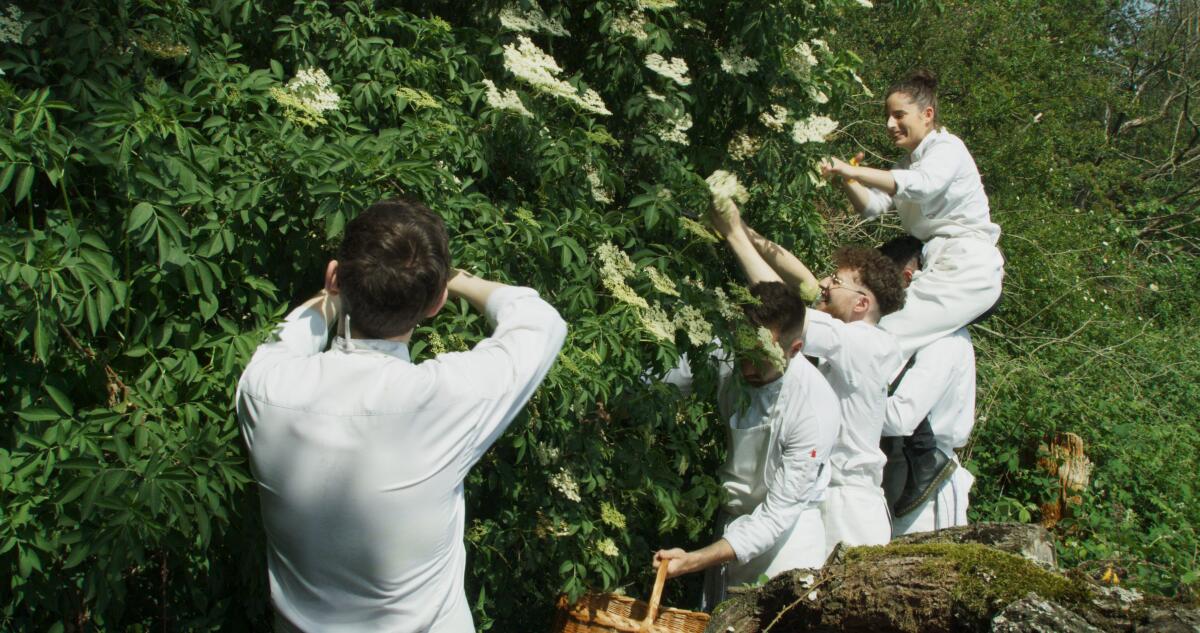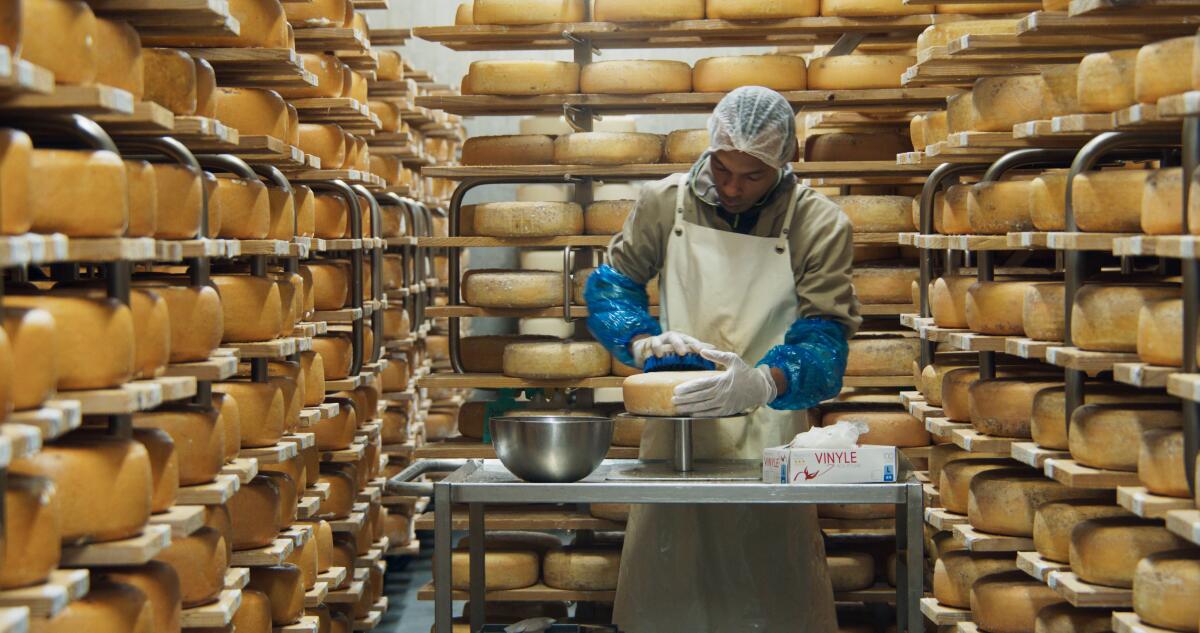Review: Frederick Wiseman rolls out a foodie masterpiece with ‘Menus-Plaisirs — Les Troisgros’

- Share via
Work meetings are the improbable lifeblood of many a Frederick Wiseman documentary, but the ones that unfold in “Menus-Plaisirs — Les Troisgros” are unusually exquisite. The subject is invariably food: its sourcing, its pricing, its preparation and presentation. The chatter mostly unfolds, in mellifluous French, over white tablecloths and stainless steel countertops, with no PowerPoints or government office furniture in sight. Light streams in not from clunky overhead fixtures but through floor-to-ceiling windows, offering gloriously unrestricted views of the verdant Loire Valley countryside.
But the pleasure of these meetings, in classic Wiseman tradition, lies in the bracing spectacle of people talking and sometimes arguing, with a passion that verges on poetry, about their work. In one early scene, Michel, the 60-something patriarch of the revered Troisgros culinary dynasty, calmly grills his son Léo about a sauce that will accompany a dish of asparagus and rhubarb. Michel has his doubts about the balance of ingredients, the necessity of combining white almond purée, soy sauce and elderberry vinegar in a recipe that he suspects might benefit from some judicious editing. But Léo assures him it will work: “You think it’s complex,” he says, “but it’s not so complex.”
That declaration illuminates something about this graceful and captivating movie, and also about the nature of a filmmaking craft that Wiseman, now 93, has practiced with quietly staggering consistency over nearly six decades. “Menus-Plaisirs — Les Troisgros” is his 44th documentary and, like its predecessors, it makes no great show of its complexity. Minute by minute, it’s a roving, inquisitive, elegantly expansive portrait of an establishment whose many constituent and tangential elements — farms and markets, kitchens and dining rooms, chefs and sous-chefs, servers and customers — function together in a kind of whirring, bustling day-to-day harmony. But it wears its intricacy with a lightness and subtlety that the culinary artists onscreen, quietly devoted to their own pursuit of delicate emulsions and harmonious flavors, might intuitively recognize.

Those artists work under the watchful eye and perceptive palate of Michel Troisgros, whose three-Michelin-starred restaurant — Le Bois Sans Feuilles, located in the central French village of Ouches — is the proud culmination of a nearly century-old family enterprise. Michel’s grandparents, Jean-Baptiste and Marie Troisgros, opened their first restaurant in 1930, across from a railway station in the town of Roanne. Michel’s children are the fourth generation to carry the torch: César serves as head chef at Le Bois Sans Feuilles, while Léo, his younger brother, is head chef at La Colline du Colombier, a more casual restaurant located in nearby Iguerande. (Hovering on the movie’s periphery are Michel’s wife, Marie-Pierre, and their daughter, Marion, who oversee the Relais & Château luxury hotel that houses Le Bois Sans Feuilles.)
Wiseman and cinematographer James Bishop (who was an assistant cameraman on the director’s earlier documentaries “La Danse: The Paris Opera Ballet” and “Crazy Horse”), drift freely among these spaces and their surroundings, laying out the connections between supply and demand, farm and table. The movie begins at an open-air market where César marvels at some giant oyster mushrooms, then moves to a cattle farm known for its humanely sourced beef. Later, we drop by a vineyard that prizes the quality of its soil, then head to a cheese cave whose precisely aged wares soon will wind up on a mammoth rolling cart. (You won’t be able to take your eyes off that cart; it’s one of the movie’s most memorable supporting characters.)
But the glory of the Troisgros family is in its kitchens, where asparagus tips are deftly pruned, snails sizzle in pans of butter, meringue domes are lightly scorched, and garlic flowers and other garnishes are applied with tweezers. Some inadequately drained veal brains become a rare source of drama, inspiring Michel, who prides himself on running a kitchen without “The Bear”-style histrionics, to gently admonish the sous-chef responsible. Later, in a scene that plays like an echo of that saucy earlier argument with Léo, Michel works his way through a plate of kidneys cooked in sriracha, calmly picking apart every detail while César listens and fumes quietly from the sidelines. It’s a marvelous sequence: a master class in culinary criticism, a snapshot of cross-generational tension and a reminder of how hard it can be to accept the offal truth.

As usual, Wiseman doesn’t spoon-feed us details of who’s who and where’s where; he trusts us to get our bearings over an effortlessly engrossing four hours. Instructively, too, he avoids the visual tropes of so much televised gastro-porn; there are no digitally shellacked entrée closeups or “Top Chef” ingredient chyrons here. Sure, your mouth may water at a quick shot of a lamb rack dipped in green curry sauce or a John Dory filet cut into the shape of a flower — an exquisite signature touch that underscores the restaurant’s emphasis on natural ingredients. But here, as in his other movies, Wiseman mostly keeps the camera at a respectful, unobtrusive distance, especially in the dining room. Our admiration for the individual creation, he suggests, shouldn’t obscure our understanding of the larger creative process.
That process is also an industrial, scientific and above all commercial one. Le Bois Sans Feuilles is both a temple of nouvelle cuisine and a shrine to sensual indulgence, and Wiseman never loses sight of the wealthy customers who keep the place in business, the kind who can afford a €300 lunch (or splurge on a €15,000 bottle of wine). If that makes the Troisgros family seem an incongruous choice of subject for this most class-conscious of American filmmakers, Wiseman has never been one to shy away from contradictions. And he finds them here in an institution whose proud tradition of culinary elitism is nevertheless inflected with a generous and egalitarian spirit.
You see this in the restaurant’s attentiveness to its customers’ dietary restrictions, food allergies and general preferences (the substitutions policy is unexpectedly accommodating), and in the downright utopian vision of a business where health and sustainability, pleasure and aesthetics flow naturally together. Most of all, you see it in the affection with which Michel greets diners old and new, often lingering over tables to tell stories and offer insights into his craft, his sensibility and what a chef can and can’t pass down to the next generation. Wiseman, whose observational approach has often been mischaracterized as objective or omniscient, here drops any pretense to neutrality, so potent and overpowering is his sense of kinship with a fellow artist. The marriage of sensibilities in front of and behind the camera is the stealthiest meeting in “Menus-Plaisirs — Les Troisgros,” and the most unexpectedly satisfying.
‘Menus-Plaisirs — Les Troisgros’
Not rated
In French with English subtitles
Running time: 4 hours
Playing: Starts Dec. 1 at Laemmle Royal, West Los Angeles
More to Read
Only good movies
Get the Indie Focus newsletter, Mark Olsen's weekly guide to the world of cinema.
You may occasionally receive promotional content from the Los Angeles Times.











